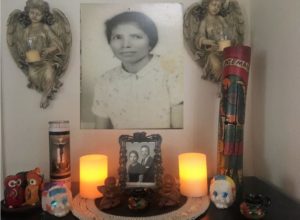Ana Castillo’s So Far From God explores the lives of a Chicana/o family in Tome, New Mexico. The book’s chapters are considered “episodes,” and each episode represents the different struggles and successes of the characters. Although this family has a close bond, each member carries different values and life perspectives. Sofi, the mother, is woman who had to learn how to be independent out of necessity. She left her home and married at a young age. She had four daughters (Esperanza, Caridad, Fe, and La Loca) with Domingo but their marriage eventually dissolved because of his addiction to gambling. He continued to make life difficult for his family since he wanted to gamble personal belongings and property. Apart from suffering the loss of her husband, Sofi also had to deal with the death of La Loca. During this time, she wondered what debt she owed God for making her suffer so much heartbreak. Sofi proves her resiliency and strength by refusing to give up anything to Domingo and supporting her family through tough times.
Through the novel, Sofia’s daughters struggle with their identities and this causes them to live in pain, suffering, and insecurity. Esperanza was the contemporary Chicana with the family who went against the traditional lifestyles her culture often imposed on women. She pursued a degree in Chiana/o studies and was determined to make a change in her community. Although one would think she was a strong, independent woman, her partner’s toxicity caused her to doubt her passions from time to time. Although she was able to leave the relationship, her life was still cut short because of masculine entities. She was sent to Saudi Arabia to report war events and her life was taken (along with others) because of the violence. Caridad was the daughter that followed the traditional values of her culture and ended up losing her identity once she lost the man whom she felt completed her existence. She had an abortion once she found out she was pregnant with his baby and soon began behaving like the “bad woman.” This “bad woman” behavior involved her going to bars late at night and bringing different men home. She then experienced a rape and her faith in men diminished completely. She decided to reclaim back her existence by exploring her spirituality and was on a mission to find inner peace. Unfortunately, exploring her identity and sexuality led her to the decision of ending her life with her lover Esmeralda since they thought that was the only way they can break free from control and judgment. Fe represents the daughter who assimilated into white culture. She got a hold of a career at a bank and developed a relationship with Tom. It seemed as though she had achieved the middle class life she always wanted but this ended once Tom left her. She would later marry her cousin but one could tell that she was miserable up until her life was taken by the chemicals caused by the military industrial complex. Finally, La Loca was the daughter that resurrected after her fatal accident. She is the figure in the family that maintained traditional skills in order to keep her culture’s values and history alive. In my opinion, I feel like she has ability to see the hypocrisy and malicious intentions in people which makes her want to keep her distance from humanity altogether.
One of the most intriguing parts of the story is how Esperanza was able to come back as a spirit, but Fe was not. Both girls led very different lives but patriarchal ideologies and US nationalism controlled their lives one way or another and eventually caused their deaths. Esperanza had so much love for the work that she did and although she loved her culture, she knew changes needed to be made. I think she was able to come back as a spirit because her work on Earth and among humans was not over yet. She always had a strong sense of determination so she wanted to make a difference even as a spiritual entity. Fe was disconnected from her culture and did not care much for staying in contact with them since she was miserable for most of her life. There was no reason for her to come back with the living since living was not something she enjoyed herself; her work on Earth was done and over with. It was time to leave it completely.
Questions:
Do you think spirituality can make a difference in someone’s journey towards healing?
Would you blame Chicana/o or Latina/o culture for the deaths and suffering of these women?
Do you think we really have control of our spiritual entities and be able to decide where we want to spend our afterlives?
Which character do you have the most sympathy for?



